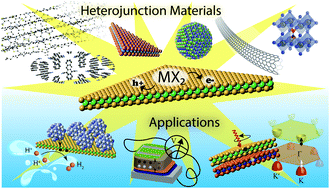Photoinduced charge transfer in transition metal dichalcogenide heterojunctions – towards next generation energy technologies
Abstract
Increasing interest in using two-dimensional transition metal dichalcogenides (2D TMDCs) in optical energy conversion technologies creates a demand for improving the yields and lifetimes of photogenerated charge carriers. Despite inherently fast photocarrier decay in neat 2D TMDCs, the unique photophysics in these quantum-confined systems motivates continued effort to control the evolution of photoexcited states and create functional devices. An intriguing strategy to accomplish this goal is to employ TMDCs in heterojunctions with appropriate semiconductors, where energy level offsets drive photoinduced charge transfer (PCT) across material interfaces. PCT in TMDC-based systems can be optimized for many different applications, such as driving free carriers to photocatalytic sites for redox reactions like water splitting, extracting charge to perform work in photovoltaics or photodetectors, and manipulating the spin and momentum valley electronic degrees of freedom for quantum computing systems. Here, we review recent strides in optimizing PCT for such applications through greater fundamental understanding of the photophysics that occurs at TMDC/semiconductor interfaces. After giving an overview of isolated TMDC properties, synthetic methods, and the basics of PCT, we discuss TMDCs in heterojunctions with several classes of materials, including other TMDCs, small molecule semiconductors, polymers, single-walled carbon nanotubes, quantum dots, perovskites, and electrolytes. In addition to highlighting the unique benefits of each materials category, we also identify parallels across common themes, such as the roles of charge-transfer states, spin, electronic coupling, delocalization, interfacial atomic morphology, and the precise design of energy landscapes to direct charge and energy motion. We hope to capture a broad range of the valuable work in this fast-paced field to inspire new research directions for employing PCT in targeted TMDC-based systems.



 Please wait while we load your content...
Please wait while we load your content...
